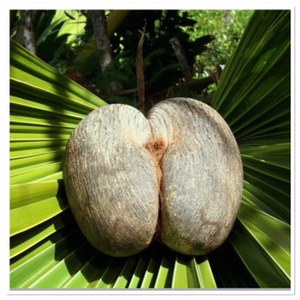Nut and tree of the coco de mer, a rare species of palm tree native to the Seychelles archipelago in the Indian Ocean, is subject of various legends and lore. Coco de mer is endemic to the Seychelles islands of Praslin and Curieuse. Before the Seychelles were discovered and settled, nuts of this species were sometimes carried by the ocean currents to distant shores, such as those of the Maldives, where the tree was unknown. These floating nuts did not germinate. The exceptional size and suggestive form of the nut, the circumstances of its discovery, and some unusual qualities of the trees have given rise to several legends.
Malay seamen had seen coco de mer nuts "falling upwards" from the sea bed, and so they had reasoned that these nuts must grow on underwater trees, in a forest at the bottom of the Indian Ocean. According to Antonio Pigafetta and Georg Eberhard Rumphius, Malay people believed that the tree was also the home of the huge bird or bird-like creature Garuda (or Rukh of the Arabs). African priests believed that the Garuda was capable of hunting elephants and tigers. The African priests also believe that sometimes the coco de mer trees rose up above the ocean surface, and when this happened, the waves that the trees created did not allow any ship nearby to sail away and the helpless sailors were eaten by the Garuda.
The coco de mer palm has separate male and female trees, unlike the coconut palm. And, unlike the more familiar fruit of the coconut tree, the coco de mer fruit is not adapted to disperse naturally by floating on the ocean water. When a coco de mer fruit falls into the sea, it cannot float because of its great weight and density; instead it sinks to the bottom. However, after the fruit has been on the sea bed for a considerable period of time, the husk drops off, the internal parts of the nut decay, and the gases that form inside the nut cause the bare nut to rise up to the surface. At that time the nut can float, but is no longer fertile, thus when the ocean currents cause the nut to wash up on a distant beach, for example in the Maldives, a tree cannot, and does not, grow from the nut. The name coco de mer is French, and means "coconut of the sea".
In the Maldives, any coco de mer nuts that were found in the ocean or on the beaches were supposed to be given to the king, and keeping a nut for yourself or selling it could have resulted in the death penalty. However, Rudolf II, Holy Roman Emperor was able to purchase one of these nuts for 4,000 gold florins. The Dutch Admiral Wolfert Hermanssen also received a nut as a gift for his services, from the Sultan of Bantam in 1602, for fighting the Portuguese and protecting the capital of Bantam. However, the nut that the admiral was given was missing the top part; apparently the Sultan had ordered the top of the nut to be cut off, in order not to upset the noble admiral’s modesty.João de Barros believed that coco de mer possessed amazing healing powers, superior even to those of "the precious stone Bezoar". In one of his books, Dr. Berthold Carl Seemann mentioned that many believed the nuts to be an antidote to all poisons.
The Dervish or Sufies of Iran make Kashkul or beggar bowl out of the half of the seed and carry it on their shoulders everyday and people on the streets used to give them gifts while they sing poems about Imam Ali and the Dervish put the gifts inside the Kashkul,later some poets/writers called their books Kashkul since there was not any specific order in their writings and their books consist of many different poems or writings on different subjects like different gifts inside the Kashkuls.



